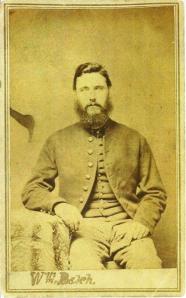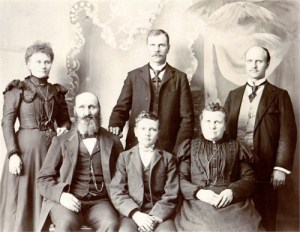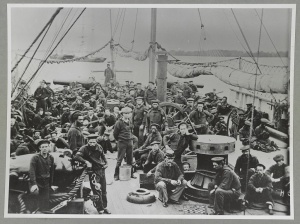A Story of a “Black Hat” of the 19th Indiana and a “Redleg” of Battery B, 4th U.S. Artillery
I recently received a scanned copy of the image above from my old friend and “pard,” Jim Oswalt. As noted, it is the image of Private William L. Balch of Company G, 19th Regiment Indiana Volunteer Infantry, which was one of the member regiments of the famed “Iron Brigade of the West.” A quick review of Balch’s service records from the American Civil War Database showed the following:
Residence Waterloo City IN;
Enlisted on 7/29/1861 as a Private.On 7/29/1861 he mustered into “G” Co. IN 19th Infantry
He was transferred out on 10/18/1864 at Petersburg, VAOn 10/18/1864 he transferred into “C” Co. IN 20th Infantry
He was discharged for wounds on 12/2/1864He was listed as:
* Wounded 6/25/1864 Petersburg, VA (Severe wound in left arm, amputated)
But, as is often the case, there is much more to the story of Private Balch’s service that the eight lines of info listed above. Born in Ohio, William, moved to Fremont, Indiana before the beginning of the war. Joining the Elkhart County Guards,which would become Company “G” of the 19th Indiana Volunteer Infantry. A good soldier, William was present from the battle of Groveton in August of 1862, on through the Wilderness campaign of 1864, apparently without suffering any wounds.
However, his luck was about to run out.
On May 25, 1864, while on duty on the skirmish line near the North Anna River, William was hit by a spent ball that penetrated his blanket roll, but left his chest severely bruised. Not hurt badly enough to need medical attention, William remained on duty. On June 25th while digging trenches near Petersburg, Virginia, William was shot by a confederate sharpshooter in the upper left arm. He was taken to the 19th Indiana’s field hospital where the regimental surgeon, Doctor Jacob Eversole, amputated his badly shattered arm close to the left shoulder. For William, the long war was over.
Returning to his Indiana home, the now one-armed carpenter filed and received a pension for the loss of his limb, and married Susan Davis in December of 1864. With his prewar occupation as a carpenter over due to the loss of his left arm, William became a painter and served as Fremont’s Justice of the Peace. He would enjoy a long life with Susan and became the father of four children. This proud old vet of the 19th Indiana, Iron Brigade, and Battery B passed away at the age of 71 years and rests today in the Old Fremont Cemetery in Steuben County, Indiana.
Analyzing the William Balch wartime image – with none of the uniforms items that would normally show Balch as soldier of an Iron Brigade regiment (M1858 Hardee hat and the M1851 Frock coat for instance) present in the image, might make one question if the subject is really a member of the famed Iron Brigade. Over the years, I have viewed identified images of Iron Brigade soldiers in what seems to be commercially made shell jackets. These seem to be worn when the subject of the image was either on convalescent leave or when the soldier was on leave after his initial three-year term of service had expired and he had mustered in as a”Veteran Volunteer.” (See the blog of the Gettysburg NMP “From the Fields of Gettysburg” for the image and story of another member of the 19th Indiana, Burlington Cunningham.) Neither of these explanations seem to work for Balch, as he was wounded before he had the opportunity to “veteranize” and it is clear that the image was taken before he lost his left arm in June of 1864.
So, why was William wearing the shell jacket in his image? My pard Jim thought perhaps the image was taken in 1861 while the 19th was still uniformed in the grey doeskin cassimere uniforms issued by the State of Indiana, a view I don’t share as the jacket appears to be quite a bit darker than grey of the state issue uniforms. I believe I found the answer on page 19 of Augustus Buell’s remembrance of service* in Battery B, “The Cannoneer”, which lists William Balch of the 19th Indiana as serving on detached service with Battery B sometime between October 1861 and June of 1862. Keep in mind that this was long before the spring of 1862 when the 19th was issued issued their distinctive U.S regular Army uniforms consisting of the M1858 Dress or Hardee Hat, the M1851 Frock Coat, and the white canvas gaiters. During this same time period the 19th Indiana was observed wearing a hodgepodge of both Indiana-issue grey and Federal-issue blue uniforms while being reviewed by General Irwin McDowell! Given the above, if you enlarge the image, it almost appears that you can make out the presence of the tape trim along the jacket opening and on the left collar, the same sort of red trim that was part of the M1854 Light Artillery shell jacket, the type of jacket that would have been worn by the regulars of “Old” Battery B. Given that he is wearing a shell jacket of some sort, it is my opinion that William sat for his image while on detached duty with Battery B, sometime in the late fall of 1861 or early spring of 1862.
* It is well-known among those who study the American Civil War that while “The Cannoneer” is rich in factual detail of the service of Battery B, Augustus Buell never served with the battery at any time during the war.
Sources:
Gaff, Alan D. On Many a Bloody Field. Four Years in the Iron Brigade. Bloomington, Indiana State Press. 1996
Herdegen, Lance J. The Iron Brigade in Civil War and Memory. El Dorado Hills, Savas Beatie. 2012.
Herdegen, Lance J. and William J.K. Beaudot. In the Bloody Railroad Cut at Gettysburg. Dayton, Morningside. 1990
On Line Sources:
http://www.19thindianaironbrigade.com/
Augustus Buell. The Cannoneer, Recollections of Service in the Army of the Potomac – https://archive.org/stream/cannoneerthe00buelrich#page/n0/mode/2up





